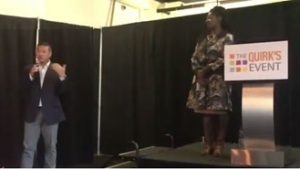This post summarizes the presentation that Courtney Minor and Tim Hoskins gave at the 2019 Brooklyn Quirk’s Event.
Gap is an American clothing and accessories retailer that has enjoyed nearly 50 years of global success with consumers. However, in recent years, they were facing a decline in shopper traffic and sales. Customers were drifting away.  They knew that a reduction of 1% in the attrition rate would translate into bringing a huge proportion of lapsed customers back into the brand and generate millions of dollars in incremental sales. Conducting consumer research to solve the customer attrition problem was imperative.
They knew that a reduction of 1% in the attrition rate would translate into bringing a huge proportion of lapsed customers back into the brand and generate millions of dollars in incremental sales. Conducting consumer research to solve the customer attrition problem was imperative.
Prior research suggested that the business problem was logistical – product wasn’t on the retail floor for customers, shipments weren’t fast enough, and online promotions were lacking. However, as a result of this research journey, Gap discovered that everything they thought was the problem wasn’t the problem at all.
It’s Time to Innovate
 In the past, Gap had generated great qualitative insights using traditional, face-to-face focus groups. However, the sample sizes were too small for their executives to make valid and reliable business decisions. They had also used full scale quantitative research that generated the “what” of the data but that research didn’t extract the deep nuances of “why.” Gap needed a qualitative solution that could be conducted at scale, one that could generate quantitative data and permit advanced statistical and analytical techniques such as drivers analysis. Even though apparel is an emotionally driven category, quantitative data would still be necessary to increase their odds of making smart business decisions. Hence, Quester’s AI moderation tool was the perfect choice.
In the past, Gap had generated great qualitative insights using traditional, face-to-face focus groups. However, the sample sizes were too small for their executives to make valid and reliable business decisions. They had also used full scale quantitative research that generated the “what” of the data but that research didn’t extract the deep nuances of “why.” Gap needed a qualitative solution that could be conducted at scale, one that could generate quantitative data and permit advanced statistical and analytical techniques such as drivers analysis. Even though apparel is an emotionally driven category, quantitative data would still be necessary to increase their odds of making smart business decisions. Hence, Quester’s AI moderation tool was the perfect choice.
Method of Choice: AI Qualitative Moderation
This study focused on re-contacting customers who had lapsed one to two years ago. A discussion guide with content that was 90% qualitative and 10% quantitative was laid out for a 30-minute in-depth interview with an AI-driven moderator. Though only 30 minutes long, AI moderated interviews often generate the same volume and quality of data as one-hour, in-person IDIs.
More than 1,700 lapsed customers participated in the study. Each person received the same base set of open-end questions, as well as probing questions specific to their target group. Some participants were so engaged with the AI moderator that they spent 45 minutes sharing their opinions. With satisfaction scores over 70%, it’s clear that participants enjoyed the research process.
The Discussion Guide
One of the key advantages of online qualitative interviews is they encourage consumers to become storytellers. Thus, the discussion guide facilitated storytelling about:
- Brands customers love. What is appealing? What drives their relationship with those brands? What experiences attract them to those brands?
- Shopping emotions. Emotions surrounding shopping for clothes to tap into System 1.
- Actual shopping experiences. Actual shopping experiences to tap into System 2.
- Role of moments. How do occasions and moments relate to the shopping experience?
- Perceptions of Gap. Why have they not shopped at Gap in the last 12 months?
The problem wasn’t what they thought
Once the AI moderator tool had collected all the data, quantitative and linguistic analysts reviewed the consumer stories for themes and ideas. Quantified linguistic analysis was conducted on the resulting data, and key ideas and code frames were built. After being in field for just 2.5 weeks, the initial report was available only two weeks after that.
Going into the research, the team hypothesized that the problem was logistical. However, as a result of the qualitative research, they discovered that Gap had a brand identity issue.
Consumers felt that Gap no longer cared about them, and that little thought and innovation went into the products. Without offering more youthful wear, a wider selection, and better-quality clothing, Gap would not be able to restore their lapsed customer base. And when 1700 people have similar stories, business executives can see the validity of the data for themselves.
Gap needed to think about how they were going to evolve their brand to be with their customers over many seasons and many years, not just for one season. They needed to rethink who their customer of the future really was.
The Insight
Gap learned that their hypothesis about the root cause of attrition was not operational. It was the product. By quantifying qualitative interviews from more than 1700 lapsed customers, they identified key attrition drivers and reactivation strategies. The Voice of the Customer revealed their weak brand identity.
So what happened after the research? Gap concentrated their strategic efforts on the product. They focused on what today’s customers want. They transformed the product testing process so that they could act on consumer feedback earlier in the new product development process, allowing them to ensure better fit and quality. And, they retrained employees and reworked the store environment to focus more on the customer mindset.
Given that the one-page summary from the research report can now be spotted on bulletin boards across the company and at people’s desks, it’s clear that the research was a success. Well done, Gap!
You might like to read these:
- 5 Essentials of Innovation
- Greenbook Webinar: Using Artificial Intelligence & Linguistics to Disrupt Traditional Innovation Methods
- What Does It Mean to Be Truly Customer Obsessed?
As President of Quester, Tim Hoskins leads a talented team of researchers, developers, and innovators who keep Quester at the forefront of the marketing research industry. Under his leadership, Quester has won numerous awards including an Ogilvy Award from The ARF and an EXPLOR Award from TMRE. He has been instrumental in the ongoing development of Quester’s artificial intelligence technology that enables new and unique approaches to solving client-side research objectives for both qualitative and quantitative methodologies. Tim was named a Volunteer of the Year by the Insights Association and currently serves on its board of directors. He is co-chair of the national Corporate Researchers Conference, and on the Collaborata board of advisors.
Quester® is award-winning consumer intelligence firm that uses proprietary artificial intelligence technologies to conduct multi-lingual qualitative research on a quantitative scale. We specialize in yielding superior consumer understanding in areas such as innovation, concept development, brand positioning, segmentation, and path to purchase. Our online software-based moderator and analytical software probes deep into participant thought processes, analyzes responses, and allows researchers to make wise business decisions grounded in data, and has netted Quester an EXPLOR Award from the TMRE and an Ogilvy Award from The ARF. Learn about our DIY tools on our website.

